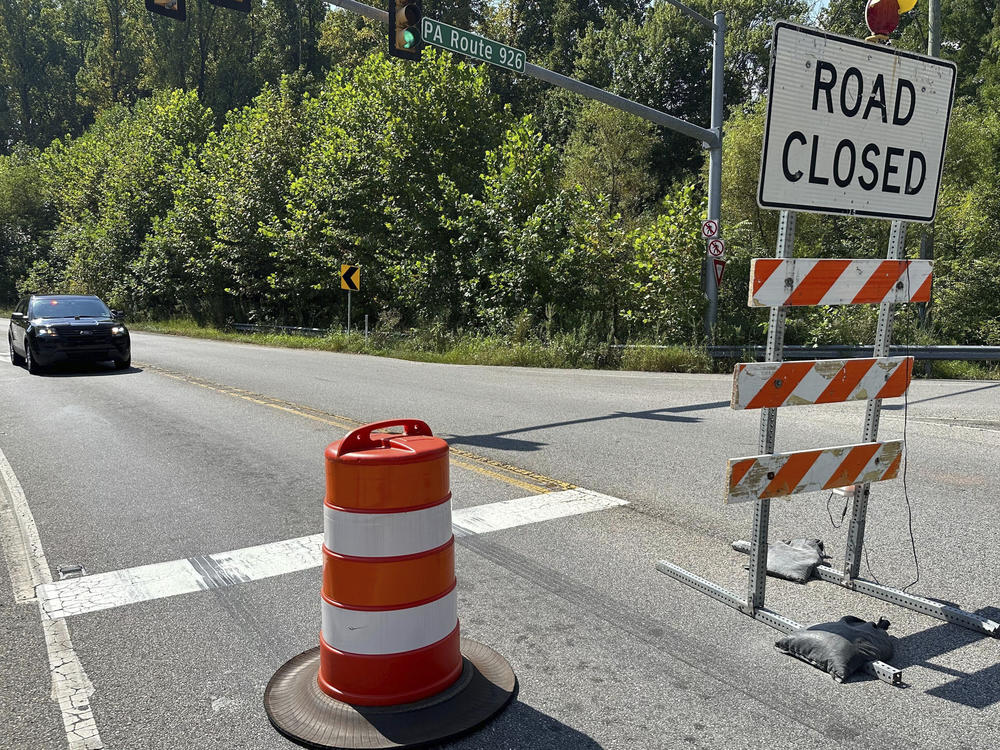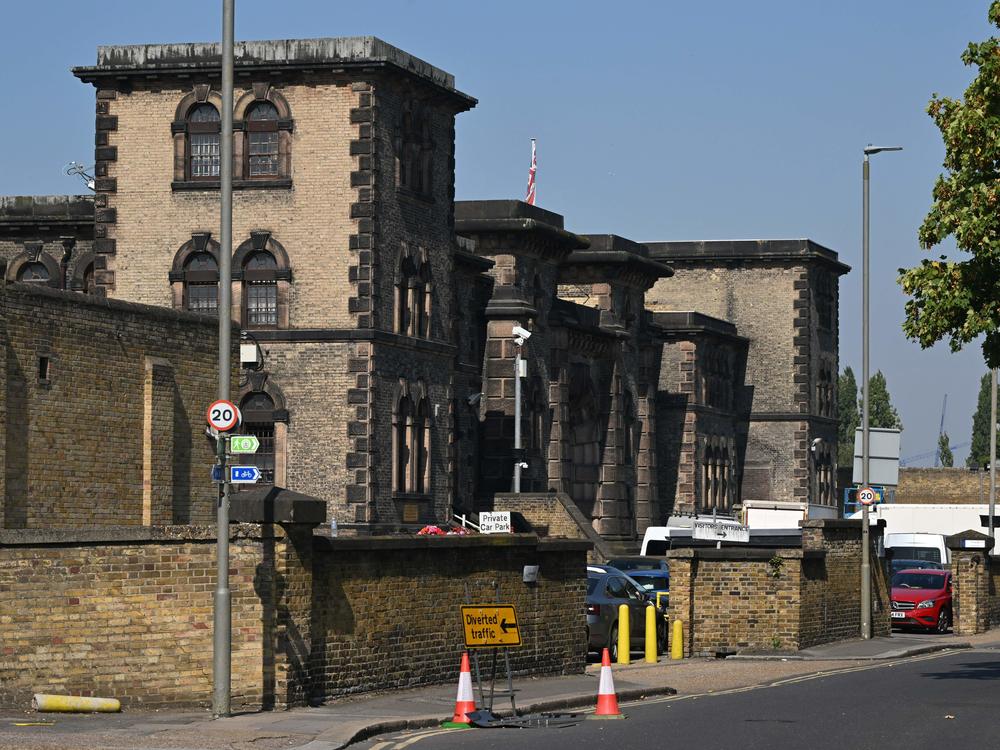Section Branding
Header Content
There are several manhunts underway this week. But don't panic, an expert says
Primary Content
Updated September 7, 2023 at 2:20 PM ET
This week is shaping up to be a big one for prison breaks.
Authorities outside of Philadelphia are searching for a convicted murderer who escaped from a jail yard last week by crab-walking up a wall, scaling razor wire and jumping from a roof.
George Washington University in D.C. went on lockdown Wednesday after a homicide suspect — who is still at large — escaped from a university hospital.
Meanwhile, in the U.K., a manhunt is underway for a terror suspect who apparently hitched a ride out of a London prison underneath a food delivery truck.
The stream of frantic manhunt headlines is ringing alarm bells and raising questions. Namely: What's going on here, and how concerned should we be?
Morning Edition asked Bryce Peterson, a senior research scientist at CNA Center for Justice Research and Innovation who focuses on issues related to technology use in correctional settings.
He says so-called escapes from custody are much more common than most people may think, and probably happen every single day. Lots of those cases likely involve people walking away from minimum security facilities or not returning from work release at their designated time.
We tend to hear about the more sensationalized cases, like if the individual has been convicted of more serious crimes, has escaped in a particularly unconventional way or evades capture for an unusually long time. But, Peterson says, escapes in general are still relatively rare.
He estimates there are over 1,000 such incidents across the U.S. each year, though tracking that data is difficult (for reasons we'll get into shortly). There were nearly 2 million people in state, federal, local and tribal criminal justice systems as of earlier this year, according to the think tank Prison Policy Initiative.
"When you think about the total number of people in custody on any given day, the fact that we have so few escapes is notable," he adds.
Peterson says when escapes do happen, they shouldn't necessarily be cause for concern, especially because it's uncommon for subjects to use violence while out in the community. But he notes that certain factors make them more likely to do so, and that's why it's important to follow guidance from local authorities.
"It's not worth people panicking just because there's someone who's escaped in your community," he says. "At the same time, of course, I would exercise caution, especially if these individuals are convicted of serious crimes and they've already displayed violent behavior."
Why people make a break for it
There is no national data on how often people escape from custody, let alone a single definition of what that means.
Most agencies, prisons and jails across the country have their own reporting systems and definitions, Peterson explains. For instance, if someone breaks out of custody but is captured within a few minutes, some places might label it an attempted escape instead of an escape. Some might classify walkaways differently from escapes.
That variation makes it hard to track such incidents. But Peterson and others have tried.
He says research his team did several years ago found 600 escapes — from both prisons and jails — in a single year, though he's fairly certain that's just a fraction of the total number.
"I would put money on the fact that it's over a thousand [each year]," he adds.
Some general patterns have emerged from that data. The vast majority of escapes happen at lower security facilities, like minimum-security prisons or prison camps, where it's easier for people to simply walk away. And many escapes — he estimates at least half — occur at local jails, where lots of people filter in and out.
"People call them prison escapes for a reason — you think of them happening from state or federal prison facilities," Peterson says. "But there's a lot of escapes happening from local correctional facilities or jails. We see that a lot, and there's probably a number of factors that play into that."
Peterson says escapes, like any other type of crime, happen when two things are present: motivation and opportunity.
His research has found that people who have longer sentences — and have only served a short fraction of them — are perhaps more likely to escape. But he's also seen escapees who are serving a short sentence in jail and end up facing more serious charges as a result.
"I remember one escape incident in particular where the individual was serving a couple of weeks of a jail sentence for a minor violation, wound up escaping, got a felony charge, and then got two years in prison," Peterson says.
He says people who are serving longer sentences may be more motivated to stay out of custody. And that could make them more likely to engage in violence or additional crimes out in the community to avoid getting caught.
"Those are the kinds of situations that I think are most volatile: The people who are kind of willing to go to the extreme to stay out of custody," he adds.
How manhunts usually end
Peterson says every available estimate shows that over 90% — usually more like 92 to 95% — of people are recaptured pretty quickly, and the vast majority of all escapees are returned within a year.
"The people who tend to remain out of custody, honestly, it's when no one is looking for them," he adds. "So if they're a very low security individual, let's say they only had a few months left on their sentence, they were convicted of a lower-security crime ... there's less people looking for them, there's less media attention, those are the people who tend to stay out of custody for longer."
It's uncommon — though not unheard of — for individuals to be hurt or killed during their escape attempts. Peterson estimates that in the "single-digit percentile."
He says people are most commonly recaptured thanks to the continued vigilance of the people looking for them, as well as public tips. It's hard for people to remain out on the lam for a long period of time without someone on the outside helping them with food and shelter.
"Everything that you need you're going to have to steal or find in some other way," Peterson adds. "The more crime you have to commit or the more interactions you have with people, the more likely it is that you're going to be recaptured."
He says people are usually captured close to the facility from which they escaped, though sometimes they make it farther. He remembers one Shawshank Redemption-like incident in which an individual tunneled through a wall and made their way to Mexico, only to be recaptured by local authorities acting on a tip some time later.
"If they are motivated to find you, they are most likely going to find you eventually, even if it takes longer than is expected," he says.
What to do if your community is on alert
Peterson says a prison break should be a cause for vigilance, not panic.
For one, he says fewer than 10% of people use violence in the community. And because that data undercounts the more mundane escapes, he estimates the number is actually somewhere below 5%.
Most of the time that people on the run do resort to violence, he adds, it's not a serious violent crime but something like carjacking or stealing.
However, individuals who have committed more serious crimes before their escape, have longer sentences (and less to lose) and are highly motivated to stay out of custody may be more prone to violence.
Peterson urges people to look to local authorities for more specific information about the individual and the risk they may pose to the public, and modify their behaviors accordingly.
"It certainly makes sense to exercise caution, to follow whatever local authorities are saying about staying inside or locking your doors or whatever that may be," he says.
And if someone escapes from a facility in your area, how concerned should you be that it might happen again?
Peterson says his team does see repeat escapes happening at the same facilities — but because they're so rare overall, it's still rather uncommon. Plus, facilities typically investigate the incident and then work with experts to address whatever made the escape possible in the first place.
"Typically when escapes occur, it's usually an individual taking advantage of a specific lapse in security or some specific issue in that facility," he says. "And that usually can be rectified."
Copyright 2023 NPR. To see more, visit https://www.npr.org.



